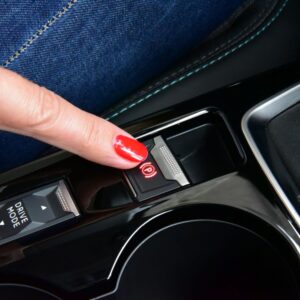Q: Where is the Parking Brake Typically Located?
A: The parking brake’s location depends on its type. The pedal parking brake is usually located to the left of the driver’s footwell, keeping it separate from the accelerator, brake, and clutch (for manual transmission) pedals. Meanwhile, the center lever parking brake and stick lever parking brakes sit between the front seats for the driver and passenger. The pull handle parking brake’s location varies but is usually within easy reach of the driver and often works with the pedal variation. Finally, the button that engages the electronic parking brake often appears on the instrument panel or center console.

The parking brake prevents the vehicle from moving while it’s parked. Also called the emergency brake or hand brake, it’s a mechanical system that can operate separately from the service brakes. As mentioned, there are several different variations of parking brakes: The center lever parking brake, pedal parking brake, stick lever parking brake, pull handle parking brake, and electronic or push-button parking brake.
How Does the Parking Brake Work?
You engage the parking brake by pulling on the lever or pushing the pedal. The parking brake cables transmit the force from the control mechanism to the rear brakes, which act as your vehicle’s parking brakes.
In vehicles with drum brakes on their rear wheels, engaging the parking brake makes the parking brake cables pull a lever. The level compresses the brake shoes, stopping the wheels–and the vehicle–from moving.
The parking brake works differently in vehicles with rear disk brakes. When you use it, the parking brake cables operate a corkscrew device that presses a piston into the brake pads.
Both parking brake types lock themselves. They won’t release the brake until you release the control lever or foot brake.
Tips on How to Access the Parking Brake
The parking brake sometimes stops responding because of an issue with its lever. You can resolve the issue by adjusting the lever. Use a trim tool to detach the parking brake lever, remove the boot, and tighten the adjuster bolt.
If adjusting the parking brake lever didn’t fix the problem, check the parking brake cables. The cables might have snapped or corroded, so you must replace them. Also, check the connection with the brake drums. A loosely connected parking brake cable won’t engage the brakes.
Any information provided on this Website is for informational purposes only and is not intended to replace consultation with a professional mechanic. The accuracy and timeliness of the information may change from the time of publication.

































